Papers by Shu-ichiro Inutsuka
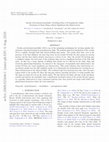
The Astrophysical Journal, 2020
Secular gravitational instability (GI) is one of the promising mechanisms for creating annular su... more Secular gravitational instability (GI) is one of the promising mechanisms for creating annular substructures and planetesimals in protoplanetary disks. We perform numerical simulations of the secular GI in a radially extended disk with inward drifting dust grains. The results show that, even in the presence of the dust diffusion, the dust rings form via the secular GI while the dust grains are moving inward, and the dust surface density increases by a factor of ten. Once the secular GI develops into a nonlinear regime, the total mass of the resultant rings can be a significant fraction of the dust disk mass. In this way, a large amount of drifting dust grains can be collected in the dusty rings and stored for planetesimal formation. In contrast to the emergence of remarkable dust substructures, the secular GI does not create significant gas substructures. This result indicates that observations of a gas density profile near the disk midplane enable us to distinguish the mechanisms for creating the annular substructures in the observed disks. The resultant rings start decaying once they enter the inner region stable to the secular GI. Since the ring-gap contrast smoothly decreases, it seems possible that the rings are observed even in the stable region. We also discuss the likely outcome of the non-linear growth and indicate the possibility that a significantly developed region of the secular GI may appear as a gap-like substructure in dust continuum emission since dust growth into larger solid bodies and planetesimal formation reduce the total emissivity.
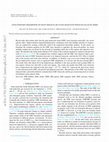
The Astrophysical Journal, 2017
Recent radio observations show that the giant molecular cloud (GMC) mass functions noticeably var... more Recent radio observations show that the giant molecular cloud (GMC) mass functions noticeably vary across galactic disks. High-resolution magnetohydrodynamics simulations show that multiple episodes of compression are required for creating a molecular cloud in the magnetized interstellar medium. In this article, we formulate the evolution equation for the GMC mass function to reproduce the observed profiles, for which multiple compression are driven by the network of expanding shells due to HII regions and supernova remnants. We introduce the cloud-cloud collision (CCC) terms in the evolution equation in contrast to the previous work (Inutsuka et al. 2015). The computed time evolution suggests that the GMC mass function slope is governed by the ratio of GMC formation timescale to its dispersal timescale, and that the CCC effect is limited only in the massive-end of the mass function. In addition, we identify a gas resurrection channel that allows the gas dispersed by massive stars to regenerate GMC populations or to accrete onto the pre-existing GMCs. Our results show that almost all of the dispersed gas contribute to the mass growth of pre-existing GMCs in arm regions whereas less than 60% in inter-arm regions. Our results also predict that GMC mass functions have a single power-law exponent in the mass range < 10 5.5 M (where M represents the solar mass), which is well characterized by GMC self-growth and dispersal timescales. Measurement of the GMC mass function slope provides a powerful method to constrain those GMC timescales and the gas resurrecting factor in various environment across galactic disks.
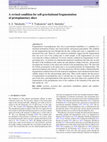
Monthly Notices of the Royal Astronomical Society, 2016
Fragmentation of protoplanetary discs due to gravitational instabilities is a candidate of a form... more Fragmentation of protoplanetary discs due to gravitational instabilities is a candidate of a formation mechanism of binary stars, brown dwarfs, and gaseous giant planets. The condition for the fragmentation has been thought that the disc cooling timescale is comparable to its dynamical timescale. However, some numerical simulations suggest that the fragmentation does not occur even if the cooling time is small enough, or the fragmentation can occur even when the cooling is inefficient. To reveal a realistic condition for fragmentation of selfgravitating discs, we perform two-dimensional numerical simulations that take into account the effect of the irradiation of the central star and radiation cooling of the disc, and precisely investigate the structure of the spiral arms formed in the protoplanetary discs. We show that the Toomre Q parameter in the spiral arms is an essential parameter for fragmentation. The spiral arms fragment only when Q < 0.6 in the spiral arms. We have further confirmed that this fragmentation condition observed in the numerical simulations can be obtained from the linear stability analysis for the self-gravitating spiral arms. These results indicate that the process of fragmentation of protoplanetary discs is divided into two stages: formation of the spiral arms in the discs; and fragmentation of the spiral arm. Our work reduces the condition for the fragmentation of the protoplanetary discs to the condition of the formation of the spiral arm that satisfies Q < 0.6.
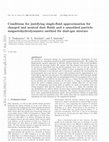
The Astrophysical Journal, 2021
We describe a numerical scheme for magnetohydrodynamics simulations of dust–gas mixture by extend... more We describe a numerical scheme for magnetohydrodynamics simulations of dust–gas mixture by extending smoothed particle magnetohydrodynamics. We employ the single-species particle approach to describe dust–gas mixture with several modifications from the previous studies. We assume that the charged and neutral dust can be treated as single-fluid, that the electromagnetic force acts on the gas, and that that acting on the charged dust is negligible. The validity of these assumptions in the context of protostar formation is not obvious and is extensively evaluated. By investigating the electromagnetic force and electric current with terminal velocity approximation, it is found that as the dust size increases, the contribution of dust to them becomes smaller and negligible. We conclude that our assumption that the electromagnetic force on the dusts is negligible is valid for the dust size with a d ≳ 10 μm. On the other hand, they do not produce the numerical artifact for the dust a d ≲ 1...
Symposium - International Astronomical Union, 1996

The Astrophysical Journal, Aug 1, 2023
Secular gravitational instability (GI) is one promising mechanism for explaining planetesimal for... more Secular gravitational instability (GI) is one promising mechanism for explaining planetesimal formation. Previous studies of secular GI utilized a razor-thin disk model and derived the growth condition in terms of vertically integrated physical values such as dust-to-gas surface density ratio. However, in weakly turbulent disks where secular GI can operate, a dust disk can be orders of magnitude thinner than a gas disk, and analyses treating the vertical structures are necessary to clarify the interplay of the midplane dust motion and the upper gas motion. In this work, we perform vertically global linear analyses of secular GI with a vertical domain size of a few gas scale heights. We find that dust grains accumulate radially around the midplane while gas circulates over the whole vertical region. We obtain well-converged growth rates when the outer gas boundary is above two gas scale heights. The growth rates are underestimated if we assume the upper gas to be steady and regard it just as the source of external pressure to the dusty lower layer. Therefore, treating the upper gas motion is important even when the dust disk is much thinner than the gas disk. Conducting a parameter survey, we represent the growth condition in terms of the Toomre Q value for dust and dust-to-gas surface density ratio. The critical dust disk mass for secular GI is ∼10−4 M * for a dust-to-gas surface density ratio of 0.01, a Stokes number of 0.1, and a radial dust diffusivity of 10−4 c s H, where c s is the gas sound speed, and H is the gas scale height.
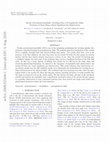
The Astrophysical Journal, Sep 15, 2020
Secular gravitational instability (GI) is one of the promising mechanisms for creating annular su... more Secular gravitational instability (GI) is one of the promising mechanisms for creating annular substructures and planetesimals in protoplanetary disks. We perform numerical simulations of the secular GI in a radially extended disk with inward drifting dust grains. The results show that, even in the presence of the dust diffusion, the dust rings form via the secular GI while the dust grains are moving inward, and the dust surface density increases by a factor of ten. Once the secular GI develops into a nonlinear regime, the total mass of the resultant rings can be a significant fraction of the dust disk mass. In this way, a large amount of drifting dust grains can be collected in the dusty rings and stored for planetesimal formation. In contrast to the emergence of remarkable dust substructures, the secular GI does not create significant gas substructures. This result indicates that observations of a gas density profile near the disk midplane enable us to distinguish the mechanisms for creating the annular substructures in the observed disks. The resultant rings start decaying once they enter the inner region stable to the secular GI. Since the ring-gap contrast smoothly decreases, it seems possible that the rings are observed even in the stable region. We also discuss the likely outcome of the non-linear growth and indicate the possibility that a significantly developed region of the secular GI may appear as a gap-like substructure in dust continuum emission since dust growth into larger solid bodies and planetesimal formation reduce the total emissivity.
arXiv (Cornell University), Feb 13, 2023
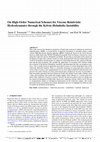
Monthly Notices of the Royal Astronomical Society
This work assesses the dissipative properties of high-order numerical methods for relativistic hy... more This work assesses the dissipative properties of high-order numerical methods for relativistic hydrodynamics. A causal theory of physical dissipation is included within a finite volume high-resolution shock-capturing framework based on the Israel–Stewart theory to study high-order WENO (weighted-essentially non-oscillatory) schemes for simulating the relativistic Kelvin–Helmholtz instability. We provide an estimation of the numerical dissipation of high-order schemes based on results obtained both with and without physically resolved dissipation and determine an empirical relationship between the numerical dissipation and the grid resolution. We consider the appearance of secondary flow features within the evolution of the Kelvin–Helmholtz instability and determine that they are numerical artifacts — this is partly based on arguments presented in terms of a frame-dependent form of the relativistic Reynolds number. There is a potential advantage of using high-order schemes in terms o...
Proceedings of the International Astronomical Union, 2018
Recent observations have emphasized the importance of the formation and evolution of magnetized f... more Recent observations have emphasized the importance of the formation and evolution of magnetized filamentary molecular clouds in the process of star formation. Theoretical and observational investigations have provided convincing evidence for the formation of molecular cloud cores by the gravitational fragmentation of filamentary molecular clouds. In this review we summarize our current understanding of various processes that are required in describing the filamentary molecular clouds. Especially we can explain a robust formation mechanism of filamentary molecular clouds in a shock compressed layer, which is in analogy to the making of “Sushi.” We also discuss the origin of the mass function of cores.

Monthly Notices of the Royal Astronomical Society, 2018
Recent numerical simulations of magnetized accretion discs show that the radialazimuthal componen... more Recent numerical simulations of magnetized accretion discs show that the radialazimuthal component of the stress tensor due to the magnetorotational instability (MRI) is well represented by a power-law function of the gas pressure rather than a linear relation which has been used in most of the accretion disc studies. The exponent of this power-law function which depends on the net flux of the imposed magnetic field is reported in the range between zero and unity. However, the physical consequences of this power-law stress-pressure relation within the framework of the standard disc model have not been explored so far. In this study, the structure of an accretion disc with a power-law stress-pressure relation is studied using analytical solutions in the steady-state and time-dependent cases. The derived solutions are applicable to different accreting systems, and as an illustrative example, we explore structure of protoplanetary discs using these solutions. We show that the slopes of the radial surface density and temperature distributions become steeper with decreasing the stress exponent. However, if the disc opacity is dominated by icy grains and value of the stress exponent is less than about 0.5, the surface density and temperature profiles become so steep that make them unreliable. We also obtain analytical solutions for the protoplanetary discs which are irradiated by the host star. Using these solutions, we find that the effect of the irradiation becomes more significant with decreasing the stress exponent.
AIP Conference Proceedings, 2005

Progress of Theoretical and Experimental Physics, 2012
Essential physical processes in the formation of protostars and protoplanetary disks are describe... more Essential physical processes in the formation of protostars and protoplanetary disks are described. Recent advances in non-ideal magnetohydrodynamics simulations, which cover a huge dynamic range from molecular cloud core density (10 4 /cc) to stellar density (10 22 /cc) in a self-consistent manner, enable us to study the realistic evolution of the magnetic field and rotation of protostars and the dynamics of outflows and jets. First we emphasize the importance of radiative heating and cooling, and describe thermal evolution in a self-gravitationally collapsing cloud. The increased pressure at the center creates the first hydrostatic core, which consists of molecular gas. After the dissociation of molecular hydrogen triggers the second gravitational collapse at the center of the first core, a protostar is quickly formed and the first core gradually transforms into a circumstellar disk that eventually accretes onto the central protostar. The importance of the short-lived first core formed in the early collapsing phase is emphasized in the contexts of driving magnetohydrodynamical bipolar outflows and self-gravitational fragmentation into binary or multiple stars. When the central density becomes sufficiently high (10 12 /cc), ohmic dissipation largely removes the magnetic flux from a collapsing cloud core, and the strongly twisted magnetic field lines are straightened. The magnetic field lines are twisted and amplified again for much higher density (10 16 /cc) where the magnetic field is recoupled with warm gas (∼10 3 K). Finally, protostars at their formation epoch have magnetic fields of 0.1-1 kG, which is comparable to observed values of pre-main-sequence stars. A substantially reduced magnetic flux at the center results in passively wound-up magnetic field lines just after the formation of a protostar. This is followed by driving of a fast bipolar jet along the rotation axis by the resultant magnetic pressure due to excessive winding. Strong collimation of the jet is due to the hoop stress of piled-up toroidal field lines. The angular momentum in a collapsing cloud is removed by magnetohydrodynamical effects such as magnetic braking and driving of outflows and jets. The rotation velocity of the protostar tends to be on the order of break-up speed at its formation epoch, and thus, a further removal mechanism for the angular momentum, such as through the interactions between the protostar, disk, jets, and winds, should be important in its long-term evolution. The circumstellar disk is born in the "dead zone," a region that is decoupled from the magnetic field. The outer radius of the disk increases with that of the dead zone during accretion from the envelope of the molecular cloud core. A rapid increase in the disk size occurs after depletion of the envelope. The circumstellar disks remain massive in their formation phase, and are subject to gravitational instability, even at 10 AU from the central stars. The further long-term evolution of massive disks is also described. This may provide an improved description for the realistic initial condition and environments for planet formation in gaseous protoplanetary disks.
Springer Proceedings in Physics, 1997
Star formation (SF) is a complex combination of various processes that include the effects of sel... more Star formation (SF) is a complex combination of various processes that include the effects of self-gravity, magnetic field, radiation, chemical reactions, etc. Theoretical modelling of SF requires division of the processes into separate pieces. In terms of basic physics, we review our current theoretical understanding of those processes: thermal evolution of gas, gravitational fragmentation to form molecular cloud cores with and without magnetic field, radiation hydrodynamical evolution of a low-mass protostar, and the evolution of a circumstellar disc.
Proceedings of the International Astronomical Union, 2009
The recent progress in our understanding of the dynamics of muliti-phase interstellar medium (ISM... more The recent progress in our understanding of the dynamics of muliti-phase interstellar medium (ISM) is reviewed. Non-linear perturbations (e.g., shock waves or time-dependent radiation field) lead to the interchange between warm phase and cold phase via thermal instability. Dynamical modelling of this phase transition dynamics is essential in describing ubiquitous turbulence in ISM and the formation of molecular clouds. A concept of magnetically multi-phase medium is introduced. Recent finding of the magnetic field amplification in the blast wave propagating in magnetized multi-phase ISM is providing a strong motivation for rapid acceleration of cosmic rays.
Astrophysics and Space Science Proceedings, 2014
We discuss the formation and early evolution of protostars and protoplanetary disks. Recent advan... more We discuss the formation and early evolution of protostars and protoplanetary disks. Recent advances in theoretical modelling with resistive magnetohydrodynamical codes with various numerical techniques has dramatically improved our understanding on the driving of outflows/jets and the formation of protoplanetary disks. The circumstellar disk is born in a “dead zone,” a region that is de-coupled from the magnetic field. The outer radius of the disk increases with the outer boundary of the dead zone during the phase of gas accretion from the envelope of the molecular cloud core. The rapid increase of the disk size occurs after the depletion of the envelope. Circumstellar disks remain massive in their formation phase, and are subject to gravitational instability, even at 10 AU from the central stars.
Astrophysics and Space Science Library, 1999
We have developed numerical methods that use particles to solve hydrodynamics and radiation hydro... more We have developed numerical methods that use particles to solve hydrodynamics and radiation hydrodynamics and reformulated Smoothed Particle Hydrodynamics using a new action principle. The force acting on each particle was determined by solving the Riemann problem. Use of the Riemann Solver strengthened the method, making it accurate for the study of strong shock phenomena. These techniques were implemented in conservation form. The method was also extended to multi-dimensional radiation hydrodynamics without invoking any diffusion approximation, being equally applicable to optically thin and thick regimes. The results of test problems in 1D, 2D, and 3D are shown.
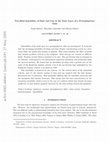
Instabilities of the dust layer in a protoplanetary disk are investigated. It is known that the s... more Instabilities of the dust layer in a protoplanetary disk are investigated. It is known that the streaming instability develops and dust density concentration occurs in a situation where the initial dust density is uniform. This work considers the effect of initial dust density gradient vertical to the midplane. Dust and gas are treated as different fluids. Pressure of dust fluid is assumed to be zero. The gas friction time is assumed to be constant. Axisymmetric two-dimensional numerical simulation was performed using the spectral method. We found that an instability develops with a growth rate on the order of the Keplerian angular velocity even if the gas friction time multiplied by the Keplerian angular velocity is as small as 0.001. This instability is powered by two sources: (1) the vertical shear of the azimuthal velocity, and (2) the relative motion of dust and gas coupled with the dust density fluctuation due to advection. This instability diffuses dust by turbulent advection and the maximum dust density decreases. This means that the dust concentration by the streaming instability which is seen in the case of a uniform initial dust density becomes ineffective as dust density gradient increases by the dust settling toward the midplane.











Uploads
Papers by Shu-ichiro Inutsuka